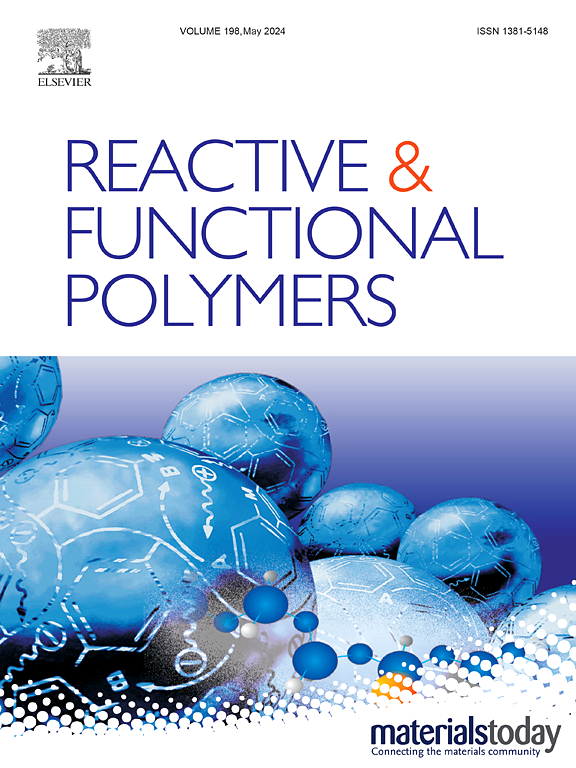Preparation of ice-nucleating glycopolymers from poly(methyl vinyl ether-alt-maleic anhydride) by modification with saccharides
IF 4.5
3区 工程技术
Q1 CHEMISTRY, APPLIED
引用次数: 0
Abstract
Ice formation can cause a serious of cryoinjuries to cells, and development of biocompatible cryoprotectants for ice control is of great importance. Herein, ice-nucleating glycopolymers are synthesized from the alternating copolymer, poly(methyl vinyl ether-alt-maleic anhydride) (PMVEA), by modification with small saccharides via one-step esterification. The prepared water-soluble glycopolymers can trigger ice nucleation at −14 to −12 °C, significantly higher than deionized water, linear poly(vinyl alcohol), and poly(ethylene glycol) (PEG). The structural differences in monosaccharide, disaccharide and trisaccharide-grafted glycopolymers have positive impacts on the chemically induced ice nucleation and the ice crystal morphology, but all of them have weak activity to inhibit ice recrystallization, similar like PEG. Analyses of differential scanning calorimetry and low field nuclear magnetic resonance suggest that the PMVEA-based glycopolymers, which can be self-associated in nanoscale by the alternating structure of hydrophobic methoxyl and hydrophilic saccharide/carboxyl groups, could have strong interactions with water molecules, thus initiating ice nucleation. Particularly, incorporation of trehalose-modified PMVEA in alginate hydrogel can enhance cryosurvival of Lactobacillus rhamnosus after cryopreservation at −20 °C in comparison with cryostorage at −80 °C. This work provides a feasible approach for preparation of ice-nucleating macromolecules for ice control during cryopreservation of cells.

用糖改性聚甲基乙烯醚-马来酸酐制备冰成核糖共聚物
冰的形成会对细胞造成严重的低温损伤,因此开发具有生物相容性的冷冻保护剂来控制冰是非常重要的。本文以交联共聚物聚甲基乙烯醚-马来酸酐(PMVEA)为原料,通过一步酯化反应与小糖进行改性,合成了冰成核糖共聚物。所制备的水溶性糖共聚物在- 14 ~ - 12℃时可触发冰核,显著高于去离子水、线性聚乙烯醇和聚乙二醇(PEG)。单糖、双糖和三糖接枝糖共聚物的结构差异对化学诱导的冰成核和冰晶形态有积极的影响,但它们对冰再结晶的抑制活性都较弱,与PEG相似。差示扫描量热法和低场核磁共振分析表明,基于pmvea的糖共聚物可以通过疏水甲氧基和亲水糖/羧基的交替结构在纳米尺度上自结合,可以与水分子发生强相互作用,从而引发冰核。值得一提的是,海藻糖修饰的PMVEA掺入海藻酸盐水凝胶中,与−80°C的低温保存相比,−20°C的低温保存能提高鼠李糖乳杆菌的低温存活率。本研究为细胞低温保存过程中冰核大分子的制备提供了一种可行的方法。
本文章由计算机程序翻译,如有差异,请以英文原文为准。
求助全文
约1分钟内获得全文
求助全文
来源期刊

Reactive & Functional Polymers
工程技术-高分子科学
CiteScore
8.90
自引率
5.90%
发文量
259
审稿时长
27 days
期刊介绍:
Reactive & Functional Polymers provides a forum to disseminate original ideas, concepts and developments in the science and technology of polymers with functional groups, which impart specific chemical reactivity or physical, chemical, structural, biological, and pharmacological functionality. The scope covers organic polymers, acting for instance as reagents, catalysts, templates, ion-exchangers, selective sorbents, chelating or antimicrobial agents, drug carriers, sensors, membranes, and hydrogels. This also includes reactive cross-linkable prepolymers and high-performance thermosetting polymers, natural or degradable polymers, conducting polymers, and porous polymers.
Original research articles must contain thorough molecular and material characterization data on synthesis of the above polymers in combination with their applications. Applications include but are not limited to catalysis, water or effluent treatment, separations and recovery, electronics and information storage, energy conversion, encapsulation, or adhesion.
 求助内容:
求助内容: 应助结果提醒方式:
应助结果提醒方式:


